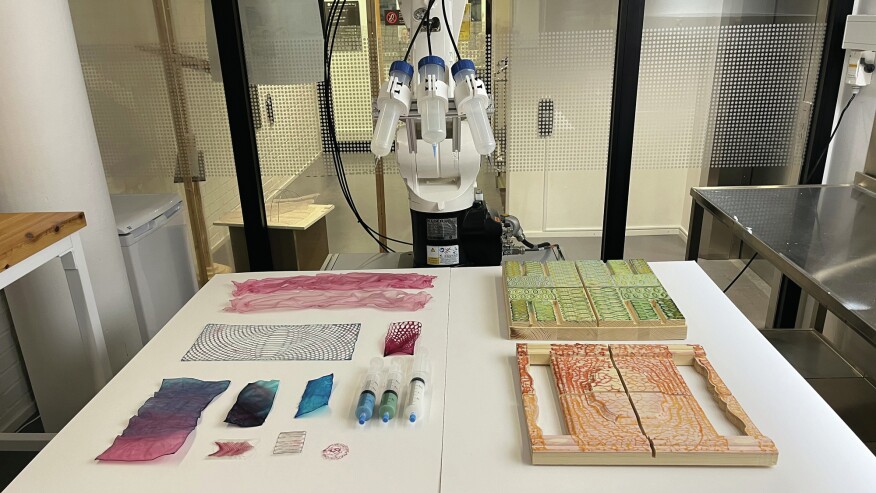
3D printing has been heralded as an environmentally advantageous method to make building products. One benefit is the potential material savings associated with reduced formwork or molds. Another is the energy savings in transportation and other distribution-related activities when products are fabricated on-site.
Despite these savings, the embodied energy of 3D printed materials may not differ significantly from traditionally manufactured products. For example, concrete and steel's most significant environmental impacts are associated with their material processing prior to casting or molding. For this reason, researchers have been exploring alternative 3D printing feedstocks with environmental performance as a primary focus.
One promising contender is nanocellulose. Cellulose, found in the cellular walls of plants, is the most prevalent biological substance on the planet. Nanocellulose is a version of the material in nanostructure form and is desirable for its high strength, surface energy (good for adhesion), and biocompatibility. Scientists are increasingly eager to exploit these traits in the development of new products and processes, particularly given cellulose’s low carbon footprint (microcrystalline cellulose has a global warming potential of 430 kg CO2/ton).
3D-printable cellulose offers an ideal combination of process and material advantages: a resource-effective method utilizing an environmentally friendly substance. Initially employed to fabricate small-scale items for textile and medical industries, 3D-printed cellulose is increasingly considered for building construction. For example, researchers at Sweden’s Umeå University began exploring the application of cellulosic materials in 3D printing in 2015. In the so-called “+Project”, they experimented with various scales of building components, from door weather-stripping to complete residential structures.
That same year, scientists at Sweden’s Chalmers University of Technology and Wallenberg Wood Science Center began 3D printing nanocellulose. They recently reported their progress in making architectural membranes using robotic 3D printers in Materials & Design. The Chalmers team has developed a novel method using nanocellulose hydrogel, a variant associated primarily with medical applications such as 3D-printed tissue scaffolds. Rather than maintain the wetness of the hydrogel, however, the researchers explored the attributes that result from drying the material. This approach required the addition of alginate, an algae-derived ingredient, to the nanocellulose fiber and water mixture to maintain sufficient pliability.
The selected mixture enables a highly energy-efficient fabrication process. “The robotic 3D printing system we employ does not use heat, just air pressure,” says lead author Malgorzata Zboinska. “This saves a lot of energy as we are only working at room temperature.” The heat-free method is possible based on the shear-thinning capacity of nanocellulose hydrogel. When pressure is delivered during printing, the feedstock remains liquid. However, after the pressure is released, the material solidifies and retains its shape. The team has explored a variety of dried nanocellulose prototypes for lightweight architectural products, including interior blinds and room partitions, and imagines future applications of nanocellulose acoustic panels and wall tiles.
This method of making new biobased products has significant implications for longevity. Unlike many building materials, such as steel or glass, nanocellulose naturally biodegrades, reaching the end of its useful life more quickly than its abiotic counterparts. “We, therefore, need to acquire completely new knowledge on how we could apply them in architecture, and how we could embrace their shorter life cycle loops and heterogenous behavior patterns, resembling more those found in nature rather than in an artificial and fully controlled environment,” explains Zboinska.
The closest approximation to nanocellulose in construction is wood, a material whose lifespan is controlled via well-developed construction techniques and surface treatments. However, nanocellulose, although derived from wood fibers, remains a novel material for building construction and exhibits diverse properties depending on the various processes used to make it. For example, the tensile strength of nanocellulose-derived fibers can range from 110 to 1430 MPa, and the modulus of elasticity (MOE) from 19 to 70 GPa. These figures compare favorably to wood, which has a 50 to 250 MPa tensile strength and MOE from 5 to 20 GPa. Still, these superior properties do not consider how the nanocellulose fibers perform as part of a hydrogel mixture.
Thus, many more tests—including visible experiments that engage the public—are needed for printed nanocellulose building products. According to Zboinska, “The yet not fully known properties of novel biobased materials prompt architectural researchers to establish alternative approaches to designing these new products, not only in terms of the functional qualities, but also the acceptance from the users.”
The views and conclusions from this author are not necessarily those of ARCHITECT magazine.
Read more:The latest from columnist Blaine Brownell, FAIA, includes a roundup on sustainable manufacturers in Egypt, a review of the Grand Egyptian Museum, a look into Cairo's informal settlements, a profile on textile designer and weaver Suzanne Tick, and he also looks at emerging carbon capture and storage technologies, the blue economy, and AI's impact on supply chain management.
Keep the conversation going—sign up to our newsletter for exclusive content and updates. Sign up for free.
















